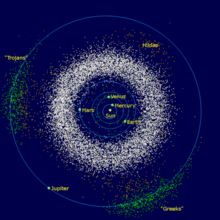(153) Hilda
|
Asteroid (153) Hilda |
|
|---|---|
| Properties of the orbit ( animation ) | |
| Orbit type | Outer main belt |
| Asteroid family | Hilda family |
| Major semi-axis | 3,972 AU |
| eccentricity | 0.138 |
| Perihelion - aphelion | 3.423 AU - 4.521 AU |
| Inclination of the orbit plane | 7.8 ° |
| Length of the ascending node | 228.2 ° |
| Argument of the periapsis | 39.1 ° |
| Time of passage of the perihelion | July 16, 2007 |
| Sidereal period | 7 a 335 d |
| Mean orbital velocity | 14.9 km / s |
| Physical Properties | |
| Medium diameter | 171 km |
| Albedo | 0.0618 |
| Rotation period | 5 h 58 min |
| Absolute brightness | 7.48 likes |
| Spectral class | P |
| history | |
| Explorer | J. Palisa |
| Date of discovery | November 2, 1875 |
| Another name | 1935 GD |
| Source: Unless otherwise stated, the data comes from JPL Small-Body Database Browser . The affiliation to an asteroid family is automatically determined from the AstDyS-2 database . Please also note the note on asteroid items. | |
(153) Hilda is an asteroid of the outer main asteroid belt discovered by Johann Palisa on November 2, 1875 . The celestial body was named in memory of the eldest daughter of the astronomer Theodor von Oppolzer , who had died a year earlier.
Hilda moves between 3.423 ( perihelion ) astronomical units to 4.551 astronomical units ( aphelion ) in 7.96 years around the sun . The orbit is inclined 7.839 ° to the ecliptic , the orbit eccentricity is 0.141.
Hilda has a diameter of 171 km. It has a dark carbon-rich surface with an albedo of 0.062. It rotates around its own axis in around 5 hours and 7 minutes.
Star occultation was observed from Japan at the end of 2002 . Hilda passed exactly in front of a star (seen from earth) and darkened its light. Based on the different course of the light curve at different observation points, it could be concluded that Hilda is a round body.
Hilda group
Hilda is the namesake of a group of asteroids that move in an orbital resonance of 3: 2 with the planet Jupiter around the sun. What they have in common is a mean distance from the sun between 3.7 and 4.2 AU, an eccentricity of less than 0.3 and an inclination less than 20 °. If you look at the distribution of the Hilda group, you can see a triangle rotating with Jupiter (which is near the center of one of the edges). This is a dynamic phenomenon that arises from the 3: 2 resonance, because of course none of the asteroids moves on a triangular orbit. But their ellipses are so interwoven in terms of time and space that a triangular distribution of the Hilda group always occurs.
See also
Individual evidence
- ^ Lutz D. Schmadel, Dictionary of Minor Planet Names , p.29 .
